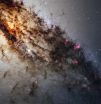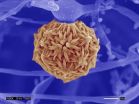(Press-News.org) Research led by astronomers at the University of Warwick has confirmed that the flash from one of the biggest and brightest bangs yet recorded by astronomers comes from a massive black hole at the centre of a distant galaxy. The black hole appears to have ripped apart a star that wandered too close, creating a powerful beam of energy that crossed the 3.8 billion light years to Earth.
Their research is published today in the Journal Science in a paper entitled "An Extremely Luminous Panchromatic Outburst from the Nucleus of a Distant Galaxy"
The high energy X-rays and gamma-rays persisted at an extremely bright level for weeks after the event, with bright flares arising when further chunks of the star fell into the black hole. The extreme brightness of this event comes from the fact that it illuminated only a small fraction of the sky, pointing a jet of light towards the Milky Way, which was detected at Earth 3.8 billion years after the star was ripped apart.
Dr Andrew Levan, lead researcher on the paper from the University of Warwick "Despite the power of this the cataclysmic event we still only happen to see this event because our solar system happened to be looking right down the barrel of this jet of energy".
The new research paper clearly establishes that the source of this event - (known now as Sw 1644+57) is right at the heart of far away galaxy, 3.8 billion light years away, at a spot which would be in the constellation Draco.
University of Warwick researcher Dr Andrew Levan said:
"The only explanation that so far fits the size, intensity, time scale, and level of fluctuation of the observed event, is that a massive black at the very centre of that galaxy has pulled in a large star and ripped it apart by tidal disruption. The spinning black hole then created the two jets one of which pointed straight to earth."
INFORMATION:
For further details please contact:
Dr Andrew Levan
Department of Physics, University of Warwick
(mobile/cell) +44 (0)7714 250373
Office +44 (0)2476 574740 (office)
a.j.levan@warwick.ac.uk
Peter Dunn, Head of Communications
University of Warwick, Tel: +44 (0)24 76 523708
Mobile/Cell +44 (0)7767 655860
p.j.dunn@warwick.ac.uk
Notes for Editors
The researchers used the Hubble Space Telescope, Swift satellite and the Chandra X-ray Observatory to study the blast. Swift's Burst Alert Telescope first discovered the source, on March 28, when it erupted with the first in a series of X-ray blasts.
The full list of research organisations credited in the paper is: The Department of Physics, University of Warwick, Department of Physics and Astronomy, University of Leicester, Leicester, Department of Astronomy, University of California, Space Telescope Science Institute, Dark Cosmology Centre, Niels Bohr Institute, University of Copenhagen, NASA , Universities Space Research Association, Columbia Astrophysics Lab, Columbia University, Instituto de Astrofissica de Andalucia (IAA-CSIC), Glorieta de la Astronomia , Herschel Science Operations Centre, ESAC, ESA, UCO/Lick Observatory, University of California, Institut de Radio Astronomie Millimetrique, Joint Astronomy center, University Park, Hilo, Center for Galaxy Evolution, University of California, Irvine, AIM, CEA/DSM - CNRS, Irfu/SAP, Centre de Saclay, Infrared Processing and Analysis Center, California Institute of Technology, Pasadena, CA, 91125, Centre for Astrophysics & Supercomputing, Swinburne University, Institute for the Physics and Mathematics of the Universe, University of Tokyo, Cahill Center for Astrophysics, California Institute of Technology, Centre for Astrophysics & Cosmology, Science Institute, University of Iceland, Center for Gravitation and Cosmology, University of Wisconsin-Milwaukee, Space Science Office, VP62, NASA/Marshall Space Flight Center, SLAC National Accelerator Center, Kavli Institute for Particle Astrophysics and Cosmology, Dunlap Institute for Astronomy & Astrophysics, University of Toronto, Computational Cosmology Center, Lawrence Berkeley National Laboratory, Astronomical Institute, University of Amsterdam, Netherlands Institute for Radio Astronomy, Benoziyo Center for Astrophysics, Department of Physics and Astronomy, Johns Hopkins University, Centre for Astrophysics Research, Science and Technology Research Institute, University of Hertfordshire, Isaac Newton Group of Telescopes, Santa Cruz de la Palma
Black hole kills star and blasts 3.8 billion light year beam at Earth
2011-06-17
ELSE PRESS RELEASES FROM THIS DATE:
Unlock Advantage is an Industry Leader in Providing T-Mobile Unlock Codes, Including for the T-Mobile G2 Android Phone
2011-06-17
A highly rated phone that Unlock Advantage provides T-Mobile unlock codes for is the T-Mobile G2 with Google. Consumers rave about this mobile device, and they have plenty of reasons.
The T-Mobile G2 with Google is T-Mobile's first Android-powered 4G smartphone. This fine-looking device has an excellent QWERTY keyboard and makes it possible to download apps and search the Internet at incredible speeds. The keyboard has three quick keys that are user-customizable and can each be set to launch any app; this is an awesome feature. When this mobile device is closed, there's ...
Searching for the 'perfect glass'
2011-06-17
Washington, D.C.—Glasses differ from crystals. Crystals are organized in repeating patterns that extend in every direction. Glasses lack this strict organization, but do sometimes demonstrate order among neighboring atoms. New research from Carnegie's Geophysical Laboratory reveals the possibility of creating a metallic glass that is organized on a larger scale. Their results are published June 17 in Science.
Scientists have discovered glasses that demonstrate order among the nearest neighboring atoms, called short-range order, and a slightly wider range of atoms, called ...
Spectacular Hubble view of Centaurus A
2011-06-17
Centaurus A, also known as NGC 5128, is well known for its dramatic dusty lanes of dark material. Hubble's observations, using its most advanced instrument, the Wide Field Camera 3, are the most detailed ever made of this galaxy. They have been combined here in a multi-wavelength image that reveals never-before-seen detail in the dusty portion of the galaxy.
As well as features in the visible spectrum, this composite shows ultraviolet light from young stars, and near-infrared light, which lets us glimpse some of the detail otherwise obscured by the dust.
The dark dust ...
Organizing Bedroom Closets is a Common Household Problem that Closets by Design has Been Helping to Solve Since 1982
2011-06-17
Closets by Design provides innovative solutions to the challenge of home organization. Recognizing that unorganized bedroom closets are a problem faced by many, Closets by Design offers not only closet ideas but also tips for problem solving.
Eliminating clutter in the home is sometimes a daunting task. One way to face the challenge is to view the issue as merely a problem to be solved.
There are many ways to approach a problem. The following are a few suggestions that together could help you conquer your bedroom closets.
If your bedroom closets are a disorganized ...
Size matters -- in virulent fungal spores -- and suggests ways to stop a killer
2011-06-17
DURHAM, N.C. – Scientists at Duke University Medical Center have found that larger fungal spores can be more lethal. Their findings about two different spore sizes of the fungus Mucor circinelloides, a pathogen that kills half or more of its victims, could help to develop new treatments and fight other types of fungal infections.
Mucor infection is in the news as an environmental fungus contracted by people who had trauma in the wake of tornadoes in Joplin, Mo. Three out of eight patients had died by June 11. This group of fungi can be common in the environment but only ...
AdaptMy.com Has Vision Tips to Reduce Falls in the Home
2011-06-17
Vision impairment is strongly associated with falls. Two of the vision limitations most commonly associated with falls are reduced visual field and impaired contrast sensitivity.
The majority of falls occur in the bathroom. Grab bars can help you regain your balance and prevent these falls, but aren't helpful if visual impairment prevents you from grasping the bars quickly. That is why Andrea Tannenbaum, president of AdaptMy.com, highly recommends bathroom grab bars with a strong contrasting color to the walls.
High contrast colors are much easier to see for people ...
Barrett's esophagus carries lower risk of malignancy than previously reported
2011-06-17
Patients with Barrett's esophagus may have a lower risk of esophageal cancer than previously reported, according to a large, long-term study published online June 16 in the Journal of the National Cancer Institute.
Barrett's esophagus is a premalignant condition, and patients who have it are often advised to have regular endoscopies to watch for signs of esophageal adenocarcinoma, the most common kind of esophageal cancer in many parts of the world. But how often Barrett's esophagus progresses to cancer has not been clear. Previous estimates of the rate of progression ...
Researchers engineer the environment for stem cell development to control differentiation
2011-06-17
Stem cell technologies have been proposed for cell-based diagnostics and regenerative medicine therapies. However, being able to make stem cells efficiently develop into a desired cell type -- such as muscle, skin, blood vessels, bone or neurons -- limits the clinical potential of these technologies.
New research presented on June 16, 2011 at the annual meeting of the International Society for Stem Cell Research (ISSCR) shows that systematically controlling the local and global environments during stem cell development helps to effectively direct the process of differentiation. ...
Plants teach humans a thing or two about fighting diseases
2011-06-17
Avoiding germs to prevent sickness is commonplace for people. Wash hands often. Sneeze into your elbow. Those are among the tips humans learn.
But plants, which are also vulnerable to pathogens, have to fend it alone. They grow where planted, in an environment teeming with microbes and other substances ready to attack, scientists note.
Now, researchers are learning from plants' immune response new information that could help them understand more about humans' ability to ward off sickness and avoid autoimmune diseases.
This week's journal Science reports findings by ...
A stem cell target for expanding waistlines?
2011-06-17
Researchers may have found the key to developing a method to rid the body of stem cells responsible for driving fat expansion. According to a report in the June 16 Cell Stem Cell, a Cell Press publication, they've landed the first protein marker on the surface of those so-called adipose stromal cells (ASCs), which serve as progenitors of the cells that make up fat tissue.
"Our long-term goal is to identify an approach to inactivate these cells in disease," said Mikhail Kolonin of University of Texas Health Science Center at Houston. "By administering a peptide with a ...





